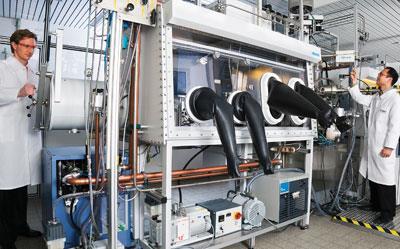Chemical companies are opening their doors to outside innovation, but does this give larger companies the monopoly on new ideas? Sean Milmo reports
Chemical companies are opening their doors to outside innovation, but does this give larger companies the monopoly on new ideas? Sean Milmo reports
The chemical industry is opening its doors to new ideas. Increasingly, companies are becoming reliant on research ideas from external sources to develop into products and processes of commercial value.
It means that the closed world of commercial R&D is less secretive. Innovation or the development of ideas from the proof-of-concept stage to market launch is becoming an open procedure in which companies seek knowledge from outside, even to the extent of sharing it throughout the supply chain.
’We used to develop our own technologies inside the company to bring them outside into the market,’ says Rob van Leen, chief innovation officer at DSM in the Netherlands. ’Now we’re reversing that to a considerable extent and bringing in new technologies from outside for further development within the company.’
In the current era of open innovation chemical companies are faced with a dilemma of how far to go with external R&D collaborations, particularly if they include projects with many participants.
To share or not to share
For some companies open innovation is merely a means for gaining knowledge from outside their own operations. For others it can be stretched to the involvement in open innovation campuses where knowledge is freely exchanged between companies in the belief that close cooperation between researchers will improve the outcome of R&D.
This broadening of research beyond traditional R&D boundaries has become crucial in the race for new, innovative technologies. At a time when the application of chemistry is often multidisciplinary, chemical companies can no longer depend solely on their in-house expertise.
’For us open innovation means access to knowledge along the entire value chain through cooperation with both science and industry - with suppliers, customers or development partners,’ explains Michael Droescher, head of innovation management chemicals at Evonik in Germany.
’Experience shows that many of today’s system solutions can no longer be developed by just one company,’ he continues. ’Instead they require the input of several industries. Innovation is not confined to a single field of knowledge but is interdisplinary and even takes place at the boundaries of disciplines.’
As examples of interdisciplinary initiatives, Evonik cites energy efficiency products in the automobile sector which could not be developed by chemistry alone.
’We supply lightweight construction materials for automobiles, an improved battery for hybrid cars, additives that improve the efficiency of lubricants and a technology for tyres with low-rolling resistance,’ Droescher says.
The company maintains around 300 R&D partnerships - 200 with universities and scientific institutes and 100 with other companies.
’Evonik is building its own competencies within the company,’ explains Droescher. ’But when it comes to building new technology platforms or tapping new markets to expand our portfolio, open innovation is indispensable to us.’
The trend to research alliances is shifting the R&D operations of large chemical companies to the middle and later stages of development. A big proportion of their expertise is in taking products and processes from the laboratory, often from external sources, through the development phases to commercialisation.
As a result research has become a broadly spread activity which takes place not only in universities and research institutes but also in smaller start-up and specialist research companies.
Selling ideas
But innovation in chemicals or the turning of ideas into money is in danger of becoming far more narrowly based, as only the biggest players may be able to provide the financial support to ensure ideas reach the market.
’A lot of people confuse innovation with R&D,’ says van Leen. ’In fact R&D is only one - although a very important - part of it. It also involves expertise in scaling up, in marketing and sales and in other fields such as IP and regulatory matters.’

And that’s where the bigger companies have the advantage. They have the funds at their disposal to invest in start-ups with promising technologies and, if necessary, the financial capacity to acquire them and ensure that their innovations will reach the global market.
As a result a sizeable gap is emerging between small and medium sized chemical companies (SMEs) and the leading chemical multinationals that can ensure they have a full innovations pipeline through a range of partnerships, collaborations and takeovers. Open innovation is in danger of becoming a benefit for the privileged few.
The vast majority of research funds from the public sector go into projects in the early stages of R&D so that academia can be a major participant.
’The further a project has moved along the development path the less academia will be involved and the more expensive it will be with little or no public sector money available,’ says Brian Murphy, former managing director and now non-executive director at Robinson Brothers Ltd (RBL), a specialty chemicals SME based at West Bromwich, UK.
’Buying start-ups is a very efficient way of acquiring good ideas but SMEs do not have the money to take over start-ups,’ adds Murphy, who is involved in UK schemes to bring together SMEs, multinationals and academia in innovation projects.
Around 15-20 years ago some large chemical companies decentralised their R&D operations so that development work on innovations could be carried out by individual business units. They had R&D teams much the same size as those run by SMEs. The objective was to bring researchers closer to the marketplace and to encourage entrepreneurship among R&D personnel.
Now chemical multinationals are centralising R&D again or are strengthening existing centralised R&D structures. Large R&D sections are seen as being not only more cost effective but also as providing the critical mass necessary for bringing innovations to market. At the same time systems have been established to ensure that close ties with the market are retained and that research partnerships can be run throughout the world.
BASF, the world’s biggest chemicals company, has around 8600 researchers working at 80 R&D sites globally on 1300 projects, which it divides into those driven by market demand and those by technological advances.
’From our point of view, there are two major sources of ideas and innovations - technology push and market pull,’ explains Dieter Jahn, senior vice president science relations and innovation management at BASF and vice president of the German Chemical Society. ’Market pull means development close together with our customers and technology push means cooperation with the best scientists at universities and research institutes.’
The company believes that for chemical companies innovation now has to serve a need for much broader applications of new products so that they cover more than just one stage within a supply chain.
’In the research of chemical companies, a paradigm shift is taking place,’ says Jahn. ’New molecules are still important but we need more and more innovative system solutions. So innovations are a challenge for the whole company, not only for the R&D divisions.’

Much of the technology push takes place in BASF’s global network of R&D centres, the biggest of which is at its main complex at Ludwigshafen, Germany. New technology is the impetus behind a quarter of its R&D projects and involves around 20 per cent of its R&D staff.
BASF is involved in around 1800 cooperations with universities, research institutes, start-ups and industrial partners worldwide. The company was one of the first to establish its own laboratory in a university - in Strasbourg, France - while academics are also seconded to R&D units on its own sites. Recently staff from external research companies have started to work with BASF researchers at the company’s new joint innovation lab (JIL) at Ludwigshafen.
Evonik has a science to business centre in Marl, Germany, where university and company researchers collaborate on projects for the development of new products and processes. And Toray Industries of Japan has set up a new frontiers research centre for nanotechnology and biotechnology schemes for which laboratory space is made available to academic institutes.
Ciba Specialty Chemicals, Basel, Switzerland, which is currently subject to a ?3 billion takeover bid by BASF, has been stepping up its efforts to forge research partnerships with academia and specialist research institutes.
’In the past five years, especially, there has been a determined effort [within the company] to reach out more broadly for both basic and applied research programmes,’ says Martin Riediker, Ciba’s chief innovation officer. ’This has resulted in several strategic collaborative liaisons - for example with the Swiss Centre for Microelectronics and the VTT Technical Research Centre in Finland - as well as contacts with 76 universities in 14 countries.’
’No company can afford to go it alone any longer - it simply does not make sense,’ he adds. ’The trick is to find the right partners - ones with whom a good rapport can be developed and mutually beneficial goals can be established.’
In a collaboration with two German engineering companies - Duerr Goup, a manufacturer of automobile paint finishing systems and Roth & Rau AG, a plasma equipment maker - Ciba has developed a technology for the three-dimensional curing of auto coatings using ultraviolet curing mechanisms with Ciba’s photoinitiators. Ionised plasma gas in a vacuum chamber provides the source of the UV radiation.
’Duerr built the unit where the curing actually occurs and Roth & Rau contributed the expertise in plasma technology,’ Riediker explains. ’Together we have a solution for the automotive industry that none of us could have brought to market solely on the basis of our technological competences.’
Ciba has adopted a strategy of forging partnerships with R&D start-ups and spin-outs from universities and research institutes in order to develop new technologies outside its core competences. It has recently become an equity partner in Pangaea Venture Capital Fund, Vancouver, Canada, which focuses on start-up companies in the fields of energy, the environment and electronics.

For DSM, investing in start-ups with the possibility of eventually taking them over is a way of translating its own innovation ideas into products for the marketplace.
’We look at what’s needed in the market and then our own capabilities in fulfilling these needs,’ says van Leen, giving as an example the demand for food ingredients which help to combat obesity. ’If our own skills and technologies are not sufficient we then search for them outside the company. We then set up a collaboration deal or buy a start-up. We spend €30 million [?23 million] annually in filling technology gaps.’
DSM has direct venture capital investments in over 20 start-ups, some of which will lead to takeovers. One of its latest acquisitions has been that of Polymer Technology Group (PTG), Berkeley, California, a developer of polyurethane, polycarbonate and silicon-based materials for medical devices.
’The sort of start-ups we acquire are ones which have found that they can no longer expand by themselves and want to join with a bigger company to bring their products to the global marketplace,’ says van Leen.
DSM’s broad attitude to open innovation is also demonstrated in its involvement in public/private partnerships in the Netherlands, usually in the form of alliances between large, small and medium sized companies, academia and the Dutch government. The latest of these Dutch projects in which DSM is involved is the BioMedical Materials (BMM) programme backed by the government, academia and industry whose aim is to make the country a world leader in biomedical materials.
In partnership with the Limburg regional development authority (LIOF), the company has also established an open innovation campus on the Chemelot site, Geleen, southern Netherlands, which at present accommodates around 60 companies.
’At the moment the open innovation is coming from the ability of the companies to apply our technologies, or use our infrastructure,’ says van Leen. ’But as the park develops further we expect it will be an area of open innovation for us as well.’
DSM, which over the last 50 years has moved from being a coal mining company to a leader in life sciences and materials, regards itself as a pioneer of the concept of open innovation. Now it has reached a stage where many of its competitors are embracing the concept. But it looks likely that DSM will be among a number of pacesetters to show the way forward.
Sean Milmo is a freelance science writer based in Essex, UK






No comments yet